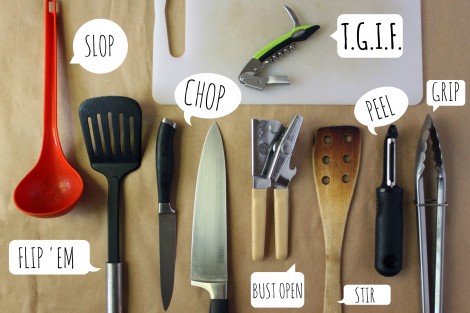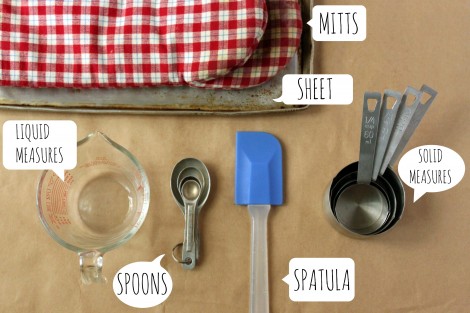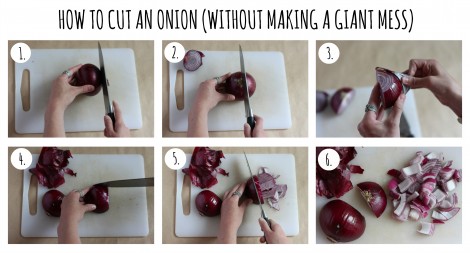During my first year at U of T, in a communal kitchen in Bowles-Gandier residence at Victoria College, I baked a batch of cookies that not only burned to ash, but caused the oven to catch on fire.
Welcome to first-year cooking.
The good news is twofold: first, you’ll get better with time. Second, until you do, you’re not alone. Most students heading to university for the first time probably don’t have a clue what they’re doing in the kitchen either. But there will come a time when your strict regimen of dining hall, pizza, and takeout truck food will grow tiresome. You will suddenly feel desperate for a home-cooked meal. So go make friends with your kitchen, and visit it often. Just like writing essays, translating Ancient Greek, or doing calculus, cooking is a skill that improves with practice.
Once you’ve acquired the necessary tools and practiced the simple techniques detailed below, try your hand at some real cooking with these simple recipes.
Tools of the trade
Before you get started on your culinary adventure, you need to stock your kitchen with the right tools. You don’t need to spend a small fortune, with great deals available at Honest Ed’s, the Tap Phong Trading Co. on Spadina, dollar stores, Value Village, or — since you’re likely to head there anyway — Ikea.
Knives: The most important, most useful tools in any kitchen. Of all the items to splurge on, knives are the one. Cheap, dull knives are not only useless but dangerous, as the harder it is to slice something, the more likely it is that the knife will slip and slit your fingers instead. Start with one chef’s knife or santoku knife, and one smaller paring knife. Skip the expensive sets that are full of blades you’ll never use. Department stores like the Bay often have high-quality knives on sale.
Cutting boards: Grab a set, and assign one for onions and garlic, one for meat and fish, and one for the rest. Skip the smaller cutting boards — you will almost always wish you used a larger one.
Kettle: Not good only for tea, but useful for boiling water for noodles if you’re pinched for time or can’t watch the pot.
Baking spatula, wooden spoon, plastic flipper spatula, ladle, and plastic-tipped tongs: So many pans are covered in a non-stick coating these days, it’s not worth buying the metal equivalents of these and risking scratching them.
Baking sheet: Useful for heating up pizza and baking cookies alike. Make sure to check the size of your oven first; don’t buy a sheet that’s too big to fit inside.
Pots and pans: A small, a medium, and a large saucepan; a medium nonstick cast aluminum pan (10-inch); and a large, heavier duty steel pan with steep sides (14-inch). Buy a single lid that will cover the larger pans/pots, or just use a plate.
Measuring cups, measuring spoons, vegetable peeler and can opener: Especially the can opener.
Colander or mesh sieve: It’s not worth losing your noodles in the sink.
Corkscrew: Not one of those horrible ones with arms. Get one that folds into itself, with a mini label-knife.
Getting the grub
Once your kitchen is stocked with tools, all you need is the actual food to make some magic. There are a number of big-box grocery stores around campus, but in addition to being overwhelming, they’re also on the expensive side. Fortunately for you, St. George campus is situated within easy walking distance of two of Toronto’s most vibrant (and least expensive) food neighbourhoods: Kensington Market and Chinatown.
Kensington’s got you covered for local, in-season produce at reasonable prices, and dry-goods stores that offer everything from exotic candy to South American pantry staples, to health food items. The butcher shops and fishmongers are friendly, knowledgeable, and always willing to offer advice on how best to cook their products; however, since the products are usually locally-raised and sustainable, you’ll be paying a higher price in accordance with quality.
If your budget is tight and you aren’t terribly fussed about where your protein came from or what it ate, then Chinatown is the place for you — and if you’re a vegetarian, the tofu is cheaper here too. Some of the bigger stores, like Oriental Harvest or Lucky Moose Food Mart, are your best bet for one-stop grocery shopping. Chinatown produce is the cheapest available downtown, though — as with the meat — it won’t likely be local or in-season. For pantry items, though, Chinatown beats Kensington by far. You’ll find all the same brands for soy sauce, honey, ketchup, jams, peanut butter, and so forth, at prices considerably lower than the major grocery stores.
The basics
Keeping your digits intact
First, secure your cutting board. If it seems like it’s wobbling or slipping, dampen a kitchen towel and place it underneath to stabilize your cutting surface. If you’re gripping your food in your left hand and cutting with your right, make sure to guide the knife with the knuckles of your left hand, and not your fingertips. Always make sure to keep your fingertips curled slightly under, and to bend your thumb out of the way. When you’re learning to chop for the first time, go slowly. You’ll get faster with practise; the goal is precision rather than speed. And, as mentioned above, always use sharp knives; it’s the dull ones that endanger your digits.
Not all produce needs refrigerating
Many fruits and vegetables stay fresh longer if they aren’t refrigerated. Keep your onions and garlic in a dark, dry place like a drawer or cupboard. Keep apples, pears, peaches, all citrus, tomatoes, avocadoes, and bananas in a bowl on your counter. If you’re eating them in the near future, even berries taste better unrefrigerated.
Fresh herbs
To prolong the lifespan of fresh herbs, place them in a glass filled halfway with water. Cover the glass with a small plastic bag and secure it with an elastic. Store in the fridge. Otherwise, chop up the remaining herbs and fill each cube of an ice tray three-quarters of the way full with the herbs. Cover with water and freeze. Then remove the cubes, put in a labelled bag, and throw into soups, stews, or curries.
Dried spices 101
As herbs are dried for storage, their flavour increases in intensity. In general, if you’re substituting dried herbs for fresh ones, use about half the amount called for in the recipe. Also, most dried spices usually need to be livened up a little before using (cayenne and other chili powders being the exception). To help revive them, heat a dry saucepan to medium-high, then add the spices. Toast them for about a minute, stirring if necessary, and remove from heat, setting the spices aside in a bowl as soon as they become fragrant. As a rule, dried spices go stale within a few months, so it’s not worth buying them in those massive bags from the grocery store. Better to buy them in small portions from the bulk food sections in Kensington or at any health store.
First-time bakers
It pretty much all comes down to this: don’t over-pack your flour. Flour should be scooped out of the bag with a spoon, and gently shaken into the measuring cup to help aerate it. When the measuring cup is full, level the excess off with your finger. Too much flour will turn your baked goods leaden and dense. Likewise, stir your batters as little as possible, usually until the ingredients are just incorporated, to avoid over-working them, also making them dense.
Always use a bigger bowl or pot thank you think you need
That extra space isn’t going to hurt anyone, and it is truly annoying to start a project in one bowl/pot only to realize halfway through that you’re going to have to switch to another.
Salting
A little salt goes a long way. Start by adding small increments — just a pinch or two — and work your way up from there; you can always add more. If you happen to have over-salted your soup, you can try to salvage it by tossing in a couple cubed potatoes. Cook the potatoes until they’re fork-tender (usually about 20 minutes), and they should absorb some of the salt. Remove and discard the potatoes before serving.
How to peel garlic
There are two methods that work well. First, separate your garlic cloves from the head of garlic. Lay an individual clove on its side, and with a chef’s knife chop off the grey nub at the bottom. Then turn your knife on its side, press against the clove, and give it a good smash with your fist. The skin should be loosened enough to slip off. Alternatively, stick as many cloves as you’d like in a metal bowl, and then place a second, inverted bowl on top. Shake vigorously for ten seconds, and the garlic will have peeled itself.
How to chop an onion
Slice the onion in half through the root (the fuzzy nub part). Peel the outer skin off of both halves, and lay them flat, cut-side down. Grip the fuzzy root end in your left hand, and with the tip of the knife pointed towards it, make incisions that go almost-but-not-quite-all-the-way to the root — this allows it to act like as a grip, and keeps the onion from flying everywhere. Turn the knife so it is perpendicular to the cuts you made, and cut again from the outside in (moving towards the root). Discard the little nub that should be left over.
Not just for the kitchen
A lot of the ingredients or tools you have lying around can be used for more than just culinary experiments. Baking soda and vinegar can be used to clear out a clogged drain. Vinegar mixed with water in a spray bottle works well as an inexpensive all-purpose cleaner. Aluminum foil, if crumpled and wet, can be used to clean rust off of most surfaces. If you break a glass, you can press soft slices of bread over the area to catch the shards. Oddly enough you can rub a little mayo onto a water-stained wood surface, and it will help get rid of the mark.
Mostly, cooking is a skill you will hone as you practice. Be sure to wash your dishes as you go, take advantage of your leftovers, and try not to set the kitchen on fire. Improvising is also key and will help you to consolidate your mastery of the kitchen. With a bit of effort, you’ll be making ten course meals for your whole floor in no time (or, at least, some pasta for yourself).





